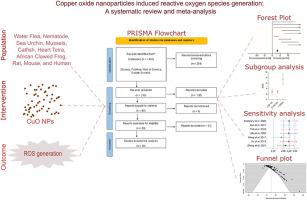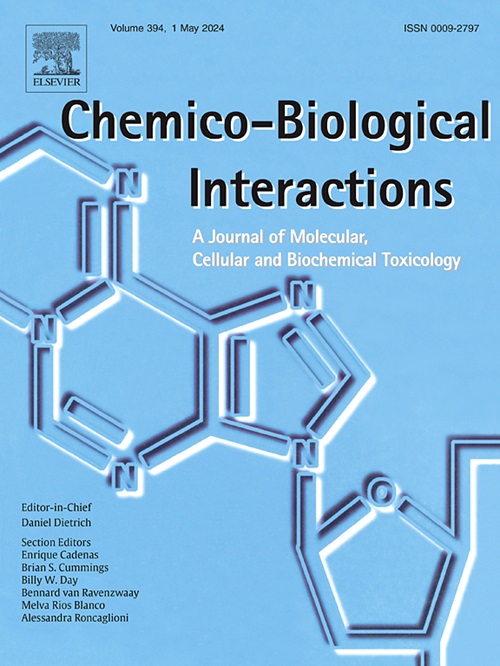氧化铜纳米粒子诱导活性氧的生成:系统综述和荟萃分析。
IF 4.7
2区 医学
Q1 BIOCHEMISTRY & MOLECULAR BIOLOGY
引用次数: 0
摘要
氧化铜纳米粒子(CuO NPs)因其增强的物理化学特性而被广泛应用于各种工业和生物医学领域。然而,人们对其进入环境后对生物系统产生的不利影响仍有疑虑。活性氧(ROS)的产生是 CuO NPs 引发毒性的主要机制之一。本荟萃分析旨在评估氧化铜氧化物氮氧化物暴露与 ROS 生成之间的关联。按照 PRISMA 指南,在 PubMed、Web of Science、Scopus 和 Google Scholar 上进行了文献调查。经过全面的初步筛选和初选,选出了 28 项体外研究进行荟萃分析。总体而言,我们的结果显示,与对照组相比,实验组的 ROS 显著增加(SMD = 3.3;95% CI:2.82-3.77,p = 0.00001),异质性很大(82%)。亚组分析显示,较大尺寸的 NPs、较高的剂量和较长的暴露时间与 ROS 的产生有关。元回归分析发现,尺寸和剂量是影响 ROS 水平的重要因素。敏感性分析发现了一项离群研究,漏斗图结果表明可能存在发表偏差。总之,我们的研究结果对氧化铜氮氧化物诱导的 ROS 生成以及纳米毒性评估中大小、剂量和持续时间等变量之间的关系提供了有价值的见解。本文章由计算机程序翻译,如有差异,请以英文原文为准。

Copper oxide nanoparticles induced reactive oxygen species generation: A systematic review and meta-analysis
Copper oxide nanoparticles (CuO NPs) are widely employed in various industrial and biomedical applications owing to their enhanced physicochemical characteristics. However, concerns regarding their adverse effects on biological systems upon entering the environment remain unexplored. The generation of reactive oxygen species (ROS) is one of the primary mechanisms in CuO NPs induced toxicity. This meta-analysis was conducted to assess the associative link between CuO NPs exposure and ROS generation. A literature survey was performed in PubMed, Web of Science, Scopus, and Google Scholar, following PRISMA guidelines. After comprehensive initial and primary screening, 28 in vitro studies were selected for meta-analysis. Overall, our results show a substantial increase of ROS in the experimental group when compared to control (SMD = 3.3; 95 % CI: 2.82−3.77, p = 0.00001), with substantial heterogeneity (82 %). Subgroup analysis revealed that larger-sized NPs, higher dosages, and longer exposure duration were associated with ROS generation. Meta-regression analysis identified size, and dosage as significant factors influencing ROS levels. Sensitivity analysis revealed an outlier study and the funnel plot results suggested potential publication bias. Overall, our results provide valuable insights of CuO NPs induced ROS generation, and the relation of variables such as size, dose, and duration in nanotoxicity assessments.
求助全文
通过发布文献求助,成功后即可免费获取论文全文。
去求助
来源期刊
CiteScore
7.70
自引率
3.90%
发文量
410
审稿时长
36 days
期刊介绍:
Chemico-Biological Interactions publishes research reports and review articles that examine the molecular, cellular, and/or biochemical basis of toxicologically relevant outcomes. Special emphasis is placed on toxicological mechanisms associated with interactions between chemicals and biological systems. Outcomes may include all traditional endpoints caused by synthetic or naturally occurring chemicals, both in vivo and in vitro. Endpoints of interest include, but are not limited to carcinogenesis, mutagenesis, respiratory toxicology, neurotoxicology, reproductive and developmental toxicology, and immunotoxicology.

 求助内容:
求助内容: 应助结果提醒方式:
应助结果提醒方式:


